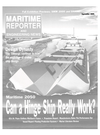
Page 38: of Maritime Reporter Magazine (September 2000)
Read this page in Pdf, Flash or Html5 edition of September 2000 Maritime Reporter Magazine
Ship Noise Guide Updated
Controlling shipborne noise is always a concern for vessel designers, builders and outfitters. The two most widely dis- tributed documents are IMO's Resolu- tion A.468(XII), "Code on Noise Levels
Onboard Ships," issued in 1981 and the
USCG's Navigation and Vessel Inspec- tion Circular (NVIC) 12-82, "Recom- mendations on Control of Excessive
Noise," issued in 1982. These two doc- uments generally discuss methods to reduce shipboard noise, recommend noise limits and describe how to mea- sure noise on ships.
One year after the USCG issued the
NVIC 12-82, a group of acoustical engi- neers from the consulting firm of Bolt
Beranek and Newman (BBN), complet- ed a report that is not as well known, which is still available from SNAME.
The Design Guide for Shipboard Air- borne Noise Control, Technical &
Research Bulletin Number 3-37 - devel- oped by Raymond Fischer, Courtney
Burroughs and Daniel Nelson was issued in January 1983. While the guide includes some of the general informa- tion that was provided by the USCG and
IMO — the T&R 3-37 went one signifi-
PHONE: (906) 863-5553 • FAX: (906) 863-5634
WALITY INTERNET WEBSITE: http://www.fernstrum.com
NOISE CONTROL cant step further — it provided noise prediction methodology. The "SNAME
Design Guide" provides a cookbook methodology to predict shipboard noise levels based on design information.
According to Burroughs, who is a pro- fessor of acoustics at Penn State Univer- sity, "The purpose of the design guide was to pull together all the information into one location and put it into a simple format for engineers without a back- ground in shipboard acoustics." While the methodology requires only general design information — information about the types and sizes of the major machinery on the ship is required as well. This would include diesel engines, gas turbines, large pumps, compressors and HVAC equipment. The SNAME
Design Guide is used by ship designers to determine what types of noise control treatments are required for a vessel. In 1991 Fischer started his own consulting firm. Noise Control Engineering, Biller- ica, Mass., to provide this service to many of the smaller shipyards in the
U.S. "The SNAME Design Guide has helped my firm provide credible design information to many clients" said Fisch- er. "But, soon after the Design Guide was issued we starting improving the methodology and today, many aspects of the SNAME Design Guide have been modified to enhance prediction accura- cy." Since its issue, the SNAME Design
Guide was never updated until last year.
With its eye on the Deep Water Project, the USCG stepped in and funded a guide revision. Due to the highly spe- cialized nature of this work, a limited competition solicitation was issued by the USCG to the original firm that pre- pared the design guide, BBN and Fisch- er's firm. Noise Control Engineering (NCE). An award was made to Noise
Control Engineering in October 1998.
Fischer's approach was simply not to just update the existing methodology, but to add prediction capability. In order to maximize the technical content, the Coast Guard funded preparation of a supplement. Fischer stated that, "the new document will also be published by
SNAME, but it must be used along with the original Design Guide." One of the new topics that have been addressed is the prediction of hydroacoustic noise sources such as propulsors, thrusters and wave impact noise. In addition to the supplement itself, the Coast Guard was also given an acoustic database that included source levels and noise control material performance data.
Circle 170 on Reader Service Card
The supplement was co-authored by Leonid
Boroditsky, a senior engineer at Fischer's firm. He contributed to sections devoted to noise in engine rooms and hydrodynamic noise sources. The wave impact algorithms were developed by Boroditsky during his 20- year career at the Research Institute of Ship- building Technology in Russia.
J USt Whyou thought we couldnilwL^ cooler!
Over our 50-year history in marine keel cooling engineering and manufacturing, R.W. Fernstrum &
Company has built a reputation of quality and service, worldwide.
Throughout the years, we've made improvements in durability and efficiency to our GRIDCOOLER® line of keel coolers. Today, we're taking our product's efficiency to a higher level. i
Introducing the -3
ENHANCED
GRIDCOOLER from R. W. Fernstrum
By using an enhanced surface on the interior of our tubing, we've increased the heat transfer capability of our keel cooler by up to 30%. On large installations, this can reduce the number of coolers required for an application. It also allows us to fit keel coolers in spaces that previously were too small.
This new advancement shows our commitment to innovation in a field where we've long been the leader. If you need a solution to a cooling problem, give us a call.
We will gladly work with you to design a keel cooling system to meet your needs.
R.W. FERNSTRUM & COMPANY 1716 11TH AVENUE • P.O. BOX 97
MENOMINEE, MICHIGAN 49858 38 Circle 287 on Reader Service Card Maritime Reporter/Engineering News

 37
37

 39
39
